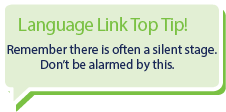What should you expect? Sarah Wall outlines how a second language develops and what you can do to support this process.
There is compelling evidence to suggest that heritage language development does not hinder but indeed supports acquisition of English. A good model in any language will help a child learn to speak additional languages and bilingualism should be seen as a positive skill for any pupil.
Cummins (2000) looked at the long term effects of second language acquisition on educational attainment. Most pupils acquired a good level of fluency for everyday conversation within 2 years. However, it took between 5 and 7 years for those pupils to catch up with first language speakers on measures of cognitive and academic language proficiency.
These stages are useful descriptors allowing you to know what to anticipate from your pupils who have English as an Additional Language (EAL).

Silent Stage – Pupils may understand up to 500 words but they may not be speaking them yet. Pupils may: be silent, copy everything, continue to use their first language.
Early Production Stage – Pupils may now understand up to 1,000 words. They will begin to produce single words and two word phrases. Pupils may use short learnt phrases. They may switch languages when speaking or borrow words from their first language.
Speech Emergence Stage – Pupils will be communicating using simple phrases and sentences. They will have an understanding of 3000+ words. They will be able to ask simple questions and initiate short conversations. They will still make grammatical errors.
Pupils will now be able to understand simple stories and some class based tasks. However, they may still have difficulty expressing ideas and feelings.
Intermediate Fluency Stage (Usually within 2 years) – Pupils are using more complex sentences and may also be writing. They are beginning to express feelings and ideas and will be able to seek clarification. They will be understanding 6000+ words.
Pupils will now be able to tackle most classroom tasks but will need help with reading comprehension. They will continue to make lots of grammatical errors.
Advanced Fluency Stage – Pupils at this stage will be using and understanding English nearly to the level of native speakers. It can take between 5-7 years to reach this level (London Bilingualism Special Interest Group).
How can you help EAL pupils to develop English?
One of the best ways to support pupils is to slow your own rate of speech down by making use of natural pauses between ideas or instructions. Here are a few more ideas:
Keep it simple – Pupils acquire a new language by hearing and understanding language that is just a little above their current level of understanding in English.
Be visual – Use as much visual support as possible in the form of drawings, photographs, maps, video, etc.
Provide links – Always try to link new information and vocabulary to what the pupil already knows and understands.
Set clear targets – Try to set clear language objectives for each task for EAL pupils, e.g. ‘pupil will learn specific nouns vocabulary’.
Pre-teach vocabulary – EAL pupils need additional exposure to new vocabulary before lessons and tasks. They will also need opportunities to practise production of new words and sounds.
Be clear – Avoid using figures of speech or ambiguous language.
Take the pressure off – Use small or paired group talking to practise new skills.
Be patient – Don’t worry if the pupil says very little at first. Plenty of listening time is important when starting a new language. Concentrate on communication rather than correction.
Relevant websites:
This website provides excellent guidance, materials and advice to help meet the needs of your EAL pupils. It includes lots of examples of differentiation of the curriculum.
This site has a talking tutor to enable communication with parents and pupils in their home language. Simply type in what you want to say and the tutor will repeat it back in the desired language. This site also features a text tool for translating school letters.
References
CUMMINS, J. (2000) Language, Power and Pedogogy; Bilingual Children in the Crossfire. Clevedon: Multilingual Matters Ltd.
London SIG Bilingualism website available at www.londonsigbilingualism.co.uk.
Please login to view this content
Login